Sustaining income in a changing market: The key to yields in 2025 and beyond
Income investing moves through cycles. Sometimes, opportunities are abundant, and other times, finding reliable yields is more challenging.
If you’ve been investing for a while, you might remember the golden era of the 2000s, when equities, bonds, and cash all delivered strong returns, and rental yields from property were attractive. Back then, asset prices were low, interest rates were high, and income was easy to come by.
But things started to change in the 2010s. Bonds and cash lost some of their appeal under the weight of zero interest rate policy (ZIRP), and property prices soared, squeezing rental yields.
Fast forward to the mid-2020s, and the income landscape has become somewhat awkward. Share market yields are hovering near 15-year lows - excluding the distortions of COVID - while rental yields in major cities have dropped to just 2.7% before holding costs, according to SQM.

Interest rates may be higher than what they were at the start of the decade, but with expectations of further easing in Australia and globally, the income appeal of bonds and cash won’t last forever. That’s why Matt Cho, Head of Multi-Asset Solutions at Vanguard Australia, encourages investors to rethink their approach.

Instead of chasing high yields from a single asset class, such as Australian shares, he advocates for a diversified strategy that leverages a number of key tools. Watch the video interview or read the summary below to understand what they are.
Key tools: Australian and international fixed interest
Given the current environment, Cho believes income investors can’t afford to overlook bonds.
With the Australian 10-year yield sitting at more than decade-high levels, fixed income has once again become an attractive source of returns, making it a crucial part of any income-focused portfolio.

And it’s not just Australia. The U.S. 10-year yield is currently around 4.3%, while Australian corporate debt and international bond indices are offering yields-to-maturity approaching 5%. These are areas Vanguard is actively exploring to enhance income potential.
“We see strong opportunities in traditional fixed income. Bond yields are favourable, and as they come down, investors stand to benefit. This is what we call the ‘coupon wall’ - a dynamic where fixed income offers an asymmetric risk and return profile,” Cho says.
Beyond higher yields, bonds also provide two key benefits:
- A real return above inflation
- Portfolio stability in volatile markets
“This is what we call a return to sound money. With yields sitting above inflation, bonds provide a buffer against equity market volatility. In times of market stress, they act as a ballast,” Cho explains.
Some investors had written off bonds in 2022, but Cho believes they remain a crucial part of balanced portfolios.
“You may recall some commentators saying in 2022 that the 60/40 portfolio was dead. But given the outlook for bonds and the return experience of 2023 and 2024, we believe the 60/40 portfolio is alive and well.”
This is particularly important in the context of expected central bank activity. With 2–3 more cuts anticipated in both Australia and the U.S., falling yields will push up the prices of existing bonds, as investors value their higher fixed rates.
Key tools: Australian and international Equities
While bonds provide stability, no Australian income portfolio is truly complete without exposure to equities. Even though the ASX’s average yield has declined, Australian shares remain a core source of income.
For investors looking to boost their dividend income, screening for high-yielding stocks can be an effective strategy. One example is the Vanguard Australian Shares High Yield ETF (ASX: VHY), which was nominated by Livewire readers as one of their top-tipped funds for 2025.
“We like having Australian shares in our diversified portfolios because they pay higher dividend yields, and because you get the benefit of franking credits on top,” says Cho.
VHY’s strategy extracts above-market income by:
- Screening for - and removing - Australian companies that aren’t forecast to pay dividends over the next 12 months.
- Ranking remaining companies from highest to lowest based on their forward dividend yield.
A similar approach is applied to international equities, which traditionally have lower dividend payouts. However, by screening for dividend-paying stocks in the same way, Vanguard’s international yield-focused strategy can push yields above 3% while still providing capital growth potential.
Key tools: Australian and international property securities
Isn't listed property dead? The asset class may not be as hot as it once was, but that doesn't mean it shouldn't be included in an income portfolio.
Real estate investment trusts (REITs) are still alive; collecting rents and paying out profits to investors. While they fell out of favour during COVID-19 due to weakness in the office market, it’s important to remember that the property sector is diverse, spanning high-growth areas such as logistics and data centres.
Unlike dividends, which are tied to corporate profits, REIT distributions are underpinned by lease agreements - which are typically indexed to or above inflation and provide stable cash flows. Over the long-term, Australian and international REIT funds have easily exceeded yields above 5%.
Blending it together: A 60/40 approach to income
Generating attractive income is no longer as simple as picking a single asset class or parking cash in a savings account and expecting reliable 5%+ returns each year. The current environment presents an opportunity for investors to step back, reassess, and build an income strategy that is both more resilient and diversified.
Vanguard is pioneering this approach with its 60/40 model in an income context - allocating 60% to growth assets like equities and property and 40% to defensive assets like bonds - as seen in its newly listed Vanguard Diversified Income ETF (ASX: VDIF).

Cho says the idea behind the strategy is to blend multiple income streams to balance cash flow, stability, and long-term growth potential. If the yield on one asset class takes a hit, others can potentially compensate.
“Diversification is the only free lunch in investing. One of our core investment principles is balance - because no single asset class delivers consistent returns year after year," he says.
Vanguard sees value in anchoring its strategy to a 60/40 framework while allowing some flexibility within asset allocation ranges.
“We’re building this portfolio to generate income and returns across the investment cycle, rather than reacting to short-term market moves,” says Cho. “We also aim to minimise unnecessary transaction costs by avoiding frequent shifts in allocation.”
Vanguard Diversified Income ETF (VDIF)
The Vanguard Diversified Income ETF seeks to provide regular income and some capital growth potential via exposure to a highly diversified, multi asset portfolio. Provides access to Vanguard’s best investment thinking, in a ready-made portfolio that makes investing simple for you.
2 topics
2 stocks mentioned
2 funds mentioned


